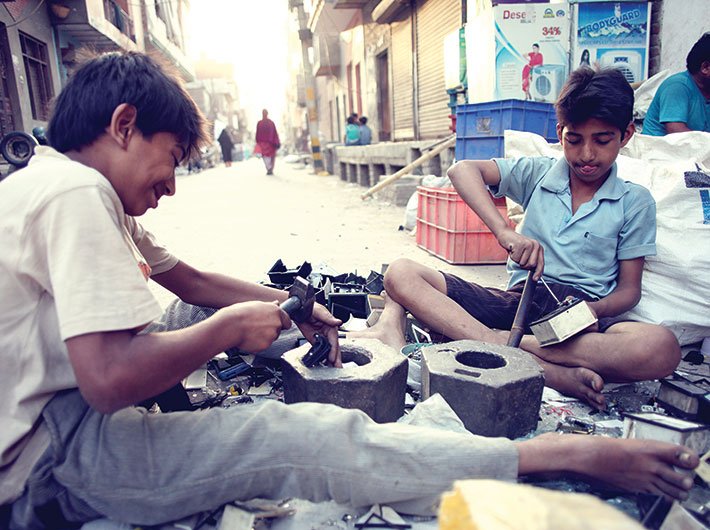India has ratified two ILO conventions on child labour. Even so, the question of poverty versus child rights still remains
In a historic move, the government, after nearly two decades, ratified two of International Labour Organisation’s (ILO) core conventions on child labour – convention number 138 (minimum age of labour) and convention number 182, which bans all the worst forms of child labour. The ratification, which took place on June 12, coincided with the ‘World Day Against Child Labour’.
Technically, the ratification was facilitated after the enactment of the amendment to the Child Labour (Prohibition and Regulation) Act, 1986 as Child and Adolescent Labour (Prohibition and Regulation) Act, 2016.
In the case of convention 138, the minimum age for labour is raised to 15 years from 14 years as it used to be, unless India wants to be declared “insufficiently developed”. In the case of the convention on the worst forms of labour, the minimum age is now 18 years and no one under that age is legally permitted to be part of any work that is hazardous to health, safety or morals.
While India’s neighbours – China, Bangladesh and Pakistan – ratified the conventions years ago, India has taken its own time. This delay does not make sense.
According to anti-child labour activist Shantha Sinha, the fear that laws against child labour would lead to unnecessary harassment of the poor and affect farming and traditional crafts had made the government drag its feet in ratifying the convention on minimum age.
But have these fears been put to rest?
While the government sat on this convention all these years, it did push a law on the right to education, making it compulsory for children aged 6-14; the upper age coincided with the minimum age for child labour in India.
The ratification has deservedly received praise from ILO and child rights activists. The government termed it as a “milestone initiative” with the “aim of realising a ‘child labour free India’ and restoring to the children what is rightfully theirs – their childhood and their dreams”.
But the question is: Will the ratification alone ensure welfare and safety of the children in India?
* * *
Aarti, 11, works as a domestic help in the DDA flats of Mayur Vihar I in the national capital. She helps her mother, who also works as domestic help.
Together, they cover as many flats as possible. “Aarti attended school when she was younger but was never interested in studies, and she dropped out,” says her mother Satyavati.
When Aarti is unable to accompany her mother, her cousin Nupur, who is barely six years old, pitches in. She is not even able to hold a broom properly but tries her best to assist in the collective efforts of Satyavati’s extended family so that there is enough income.
Satyavati is only one of the millions of migrants from states like Uttar Pradesh and Bihar who are earning their living by pulling rickshaws, working in wayside hotels or working as domestic helps in metros like Delhi.
This story is a comment on both the economic condition of migrant workers as well as the quality of the education provided to their children. Had education been relevant to them, Aarti and Nupur would have been in school. But they chose to reject an education which did not seem to be speaking in their language, or relating to them in any way.
The government has failed so far to find an answer to the question of poverty versus child rights. Asking families to strip themselves of the additional income provided by their children and not giving them alternatives to help fill the holes in their earnings, is hardly a good idea.
The question continues to evade an answer even as child labour cannot be a solution to this problem.
Many countries like Brazil have linked family allowances to compulsory education of children. According to Sinha, sending children to school solves the problem. “The true nature of education is that it equips a person to make a calculated choice at the right time. It is this capacity of a child to decide his or her own future that we take away when we deny education in the name of providing secure employment,” she says.
ILO India director Panudda Boonpala feels that more action is needed to help children. She says, “It is important that child labour elimination programmes adopt a family-centric approach rather than merely removing the child from labour and then rehabilitating him or her. One of the major reasons for child labour is that adults in the family are not earning a living wage. Hence, supplementing the existing income becomes important.”
According to Boonpala, this can be done by providing better livelihood options. For this, adult members can be connected to income generation schemes like MGNREGA and National Rural Livelihood Mission. It’s also important to enable access to skills development, so that adult members and adolescents of the family can learn new skills or enhance their existing skills. “It is seen that child labourers are from families who are socially excluded or may not have information or access to the existing social protection schemes of the government. So, enabling access to such schemes is important to absorb the life cycle shocks, and to save income which is spent by the family on benefits covered by such schemes,” she adds.
This family-centric approach also helps breaking the vicious cycle of child labour, as rescued children are often drawn back into child labour after a few months of their rescue.
“The capacities of schools and vocational training institutions also need to be built to facilitate school-to-work transition for children at the right age, so that they are prepared, have rights-based awareness and are better equipped to enter workplaces with decent wages and working conditions.”
According to NSSO’s Employment and Unemployment Survey of India, 2011-12, the number of children (in the age group 5-17) involved in child labour is over 4.2 million in rural areas and over 1.5 million in urban areas. Aarti is just one of these 1.5 million.
Furthermore, majority of child labourers are employed in the agriculture sector. Boonpala says: “When children below 14 are found working, no matter in which sector, it is child labour. Globally, agriculture remains by far the most prominent sector where child labourers can be found – 98 million or about 59 percent.”
She, however, feels that not all farming activities will suffer from the ban on child labour. “There are many activities and tasks in farming that are not hazardous and children of legal minimum age can be engaged in these areas – with protection in terms of working hours and not being exposed to chemicals and other hazards.”.
But Sinha warns against any flexibility on this matter. She warns against the ideology that children must not be taken away from farms as they learn how to cultivate, and be taught reading and writing. She calls such an argument anti-poor child.
As for convention number 182, whichbans all the worst forms of child labour, it was long overdue and it is baffling why the government took so long to ratify it. Says Boonpala: “In the worst forms of child labour, children are trafficked, forced to work to pay off debts or used in war or armed conflict; they are sexually exploited, pushed into illegal activities, or forced into work that is damaging to their safety, health and well-being.”
Child trafficking has been rampant in India but whether it translates into prostitution, pornography or abuse, and on what scale, is still a question, as rampant migration and urban poverty can lead to such exploitation too.
There is no data on prostitution, pornography or child abuse. ILO data merely says that of the total number of children in the age group of 15-17 who worked, 39.3 percent were unpaid, 10.7 percent are paid and 42.1 are casual wage workers.
The children for whom life is a living hell could be hiding in any of these categories. Will these conventions save them?
Menon is a freelance journalist.
(The article appears in the July 1-15, 2017 issue of Governance Now)

